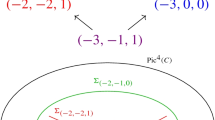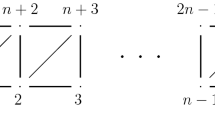Abstract
We take a sum \(C_1+rC_2,\ r\in {\mathbb {Q}}\) of a line \(C_1\) and a complete intersection curve \(C_2\) of type (3, 3) inside a smooth surface of degree 8 and with \(C_1\cap C_2=\emptyset \). We gather evidences to the fact that for all except a finite number of \(r\), the Noether–Lefschetz loci attached to the cohomology classes of \(C_1+rC_2\) are distinct 31 codimensional subvarieties intersecting each other in a 32 codimensional subvariety of the ambient space. The maximum codimension for components of the Noether–Lefschetz locus in this case is 35, and hence, we provide a conjectural description of a counterexample to a conjecture of J. Harris. The methods used in this paper also produce in a rigorous way an infinite number of general components passing through the point representing the Fermat surface of degree \(\le 9\), and many non-reduced components for such degrees.
Similar content being viewed by others
References
Carlson, J., Green, M., Griffiths, P., Harris, J.: Infinitesimal variations of Hodge structure. I, II, III. Compos. Math. 50(2–3), 109–205 (1983)
Ciliberto, C., Harris, J., Miranda, R.: General components of the Noether–Lefschetz locus and their density in the space of all surfaces. Math. Ann. 282(4), 667–680 (1988)
Ciliberto, C., Lopez, A.F.: On the existence of components of the Noether–Lefschetz locus with given codimension. Manuscr. Math. 73(4), 341–357 (1991)
Dan, A.: On generically non-reduced components of Hilbert schemes of smooth curves. Math. Nachr. 290(17–18), 2800–2814 (2017)
Greuel, G.-M., Pfister, G., Schönemann, H.: Singular 2.0. A Computer Algebra System for Polynomial Computations. Centre for Computer Algebra, University of Kaiserslautern. http://www.singular.uni-kl.de (2001)
Green, M.L.: A new proof of the explicit Noether–Lefschetz theorem. J. Differ. Geom. 27(1), 155–159 (1988)
Green, M.L.: Components of maximal dimension in the Noether–Lefschetz locus. J. Differ. Geom. 29(2), 295–302 (1989)
Maclean, C.: A second-order invariant of the Noether–Lefschetz locus and two applications. Asian J. Math. 9(3), 373–399 (2005)
Movasati, H.: A Course in Hodge Theory: with Emphasis on Multiple Integrals. http://w3.impa.br/~hossein/myarticles/hodgetheory.pdf (2019)
Movasati, H., Villaflor, R.: Periods of linear algebraic cycles. Pure Appl. Math. Q. 14(3–4), 563–577 (2018)
Voisin, C.: Une précision concernant le théorème de Noether. Math. Ann. 280(4), 605–611 (1988)
Voisin, C.: Composantes de petite codimension du lieu de Noether–Lefschetz. Comment. Math. Helv. 64(4), 515–526 (1989)
Voisin, C.: Sur le lieu de Noether–Lefschetz en degrés \(6\) et \(7\). Compos. Math. 75(1), 47–68 (1990)
Voisin, C.: Contrexemple à une conjecture de J. Harris. C. R. Acad. Sci. Paris Sér. I Math. 313(10), 685–687 (1991)
Voisin, C.: Hodge Theory and Complex Algebraic Geometry. II, Volume 77 of Cambridge Studies in Advanced Mathematics. Cambridge University Press, Cambridge, Translated from the French by Leila Schneps (2003)
Acknowledgements
I would like to thank Roberto Villaflor, Ananayo Dan and Emre Sertöz for many useful conversations in the early stages of the present article.
Author information
Authors and Affiliations
Corresponding author
Additional information
Publisher's Note
Springer Nature remains neutral with regard to jurisdictional claims in published maps and institutional affiliations.
Appendix: The computer code and data
Appendix: The computer code and data
For the proofs and computation in the present article we have written code1, code2 and code3 which use many procedures from the author’s library foliations.lib written in Singular, see [5]. These codes and the computer data produced in Table 1 can be found in https://github.com/movasati/NoetherLefschetz.
There are other two options in order to get these data. 1. The PDF file of the article is linked to the the github webpage, and clicking on the name of these codes one gets the corresponding code. In the first draft of the paper in arxiv.com the links takes the reader to the author’s webpage. 2. at the bottom of the TEX file of the article in the arxiv.com one can find the codes. In order to check the computations of the present paper, we first get the library foliation.lib from the author’s or github webpage as above.Footnote 1 Then we run the codes by doing paste copy, and of course changing the degree d and some other parameters if necessary. In order to learn about procedures, for instance DeformSpace used in Sect. 4 we run

For the computation in this paper we have used a computer with processor Intel Core i7-7700, 16 GB Memory plus 170 GB swap memory and the operating system Ubuntu 16.04. Note that we have increased the swap memory and this has been very useful for computations of the case \(d=8\).
For the convenience of the reader, we reproduce code1 which produces Table 1 for \(d=8\). We have slightly modified it from the original one in order to make it printable here. Its output consists of compo0, compo1, compo2, compo3, compo4 which contain the data of 113 (respectively 45, 1115, 18, 2) cases for \(d=8\) in Table 1. We have to run the code with d=8, tru=5 without the loop for d1,d2,m1,m2,s1,s2 and by setting d1=3; d2=3; s1=1; s2=1; m1=0; m2=0; in order to check the 5-smoothness in Theorem 2.


Rights and permissions
About this article
Cite this article
Movasati, H. Special components of Noether–Lefschetz loci. Rend. Circ. Mat. Palermo, II. Ser 70, 861–874 (2021). https://doi.org/10.1007/s12215-020-00523-4
Received:
Accepted:
Published:
Issue Date:
DOI: https://doi.org/10.1007/s12215-020-00523-4




